



Abu Dhabi: Dr. Naohiko Umewaka, Japanese Noh Master and Emeritus Professor at Shizuoka University of Arts and Culture, has been committed to Noh art for over 60 years and is a legendary figure in theater and art, particularly in Japan.
Umewaka’s family lineage in the art of Noh dates back nearly 600 years. His great grandfather, Umewaka Minoru, is credited with saving Noh Theater from extinction during the Meiji Restoration in the 19th century. Noh literally means “potential.”
It is the oldest surviving form of classical Japanese theater. From the Middle Ages, aristocrats shaped Noh by shaping it to adhere to Zen-like principles of restraint and frugality of expression. Umewaka trained by his father, the legendary Noh master Naoyoshi, has been performing since he was three, and played his first major role in Tsuchigumo at the age of nine.
He has composed, choreographed, and directed a number of new Noh plays, including the Baptism of Jesus, which was performed on December 23, 1988, at the Vatican before St. Pope John Paul II. As well as performing with his troupe worldwide, he writes and directs new Noh plays as well as contemporary plays with Noh elements. He appeared as Emperor Hirohito in the 1995 film ‘Hiroshima’.
Umewaka earned his Ph.D. in 1995 from the University of London and is currently a professor at Shizuoka University of Art and Culture in Hamamatsu, in Shizuoka Prefecture, Japan, where he does academic research on the concepts, philosophy, and internal choreography of Noh Theater.
Umewaka told Arab News Japan his story and inspiration for Noh art: “To this day, I remain intrigued by the unique literary structure of Noh. Noh is renowned for its multi-layered dream literature. Zeami, while not the originator of this concept, elevated it to an art form. My lifelong goal is to grasp how an actor should embody a dream with their flesh. It’s ironic that an actor should be gravity-free, notion-wise. The question then arises: How should our physique appear different from daily life?”
“My debut in Noh art was at the age of three, performing a short dance called ‘Shojo’ that lasted only 3 minutes. My first Noh performance where I took on a main role was in ‘Tsuchigumo’ (Earth Spider) when I was 9 years old. It was a full Noh production with two acts. Even now, I continue to train my physique to achieve Noh physicality. Over the past 40 years, I believe I have invested considerable time and effort, focusing particularly on one thing: emptiness (Mu, ‘無’)”.
“In addition to my debut in ‘Shojo’ at the age of three, ‘Dojoji’ (Dojo Temple) marked a significant milestone in my Noh experience. For many, it is considered a university graduation certificate for a professional Noh actor. I performed this piece when I was around 30 years old,” he added.
About the most inspirational thing from Japanese culture that he has adapted it into his daily life, Umewaka said: “If I were to address this question from a physical standpoint, Japanese cultural physicality does exist, as discussed by author Yukio Mishima (1925-1970) in his essay. Mishima notes that while in the West, body aesthetics are often associated with ancient Greek sculpture, such as Apollo and Venus, Japan lacks a similar physical ideal. He illustrates this by contrasting the naked body of swordsman Musashi Miyamoto (1584-1645), which is conceptually integrated with numerous swordsman techniques and mental control, hidden beneath a kimono from top to bottom (Hakama).”
“As a Noh actor, as previously mentioned, our bodies in the literary context are meant to be gravity-free, as we often find ourselves in dreams where conceptually our weight is 0 kg. Noh seems to offer a very efficient method for dieting, I suppose.”
“However, since Noh is still a physical art form, our physicality is supposed to be different from others. But in what way? I aim for my physicality to evoke the difference between dream and reality, the dream that we experience while sleeping, or rather, in Noh literature,” he added.
About his experience and challenges in his career in Noh art, Umewaka said: “I believe my childhood experiences on stage with my father, who was also my master, greatly influenced the direction of my entire career. My father taught me the importance of not blinking on stage, not through explicit instruction, but through his own performing attitude. As a child, playing roles without Noh masks, I remember being on stage in a sitting position, gazing at one point for perhaps 30 minutes without blinking. My vision was distorted by lights, and I felt it was pretty close to an epileptic state. This experience showed me that what we perceive as reality can be unstable, and what’s real is not always firm and stable. As I mentioned earlier, my investment in emptiness began in my childhood. If you ask where my position lies, I believe I’ve invested in something considered highly impractical by many, but I’m confident in its value.”
“While performing traditional pieces, I strictly adhere to the tradition, leaving no space for improvisation. However, I have also ventured into creating my own works. I’ve written one play in a traditional style and several contemporary plays that explore themes of ghosts. Although I typically refrain from using the form of Noh in my contemporary works, some people classify them as contemporary Noh. Nonetheless, I have no intention of categorizing them as such.”
Umewaka’s repertoire comprises approximately 70 plays, and he usually require one week to prepare for any of them. If he were to add another 50 plays, it might take him two weeks to prepare for each one and make his repertoire a total of approximately 130 plays.
“Every performance, whether the piece is in my repertoire or not, presents a unique challenge. I vividly remember asking my father an intriguing question when I was around 7 years old: ‘What is the most difficult Noh among all?’ His answer, ‘The easy ones are the difficult ones,’ puzzled me at the time. When I asked the same question a year later, his answer remained unchanged. I eventually stopped asking, but now, I understand what he meant,” he added.
About distinguishing Noh art from other Japanese traditional arts and performances, Umewaka said: “I’m not exaggerating when I say that Noh is at the core of Japanese performing arts, including Kabuki, Bunraku, and others. What makes Noh unique is its use of masks, a feature not found in Kabuki or Nihon Buyo dance. Bunraku, on the other hand, it stands out for its utilization of puppets. Additionally, the literary themes in Noh are distinctively multi layered which I talked about already.”
About his trips to the Middle East region, Umewaka said: “My first visit was in 1983 to Lebanon. I went back to Lebanon again and produced 3 plays at LAU (2009), at Béryth Theatre (2012) at al-Bustan Festival (2016). I was delighted to participate last month at the Diriyah Biennale in Saudi Arabia, which was connected to my involvement with Brownbook magazine. Additionally, I had the opportunity to give a lecture and demonstration recently at NYU Abu Dhabi, which was a rewarding experience.”